ACUFO-191601-31-ROCHFORD-1
In his 1925 book, “The German air raids on Great Britain, 1914-1918”, Captain Joseph Morris reported a “ghost airship” chase on January 31, 1916:
Pilot Second Lieutenant J. E. Morgan, who had taken off from Rochford at about 8:45 p.m., was at 5.000 feet when, according to his report, he saw a little above his own altitude and slightly ahead to his right, “a row of what appeared to be lighted windows which looked something like a railway carriage with the blinds drawn”, just 100 feet away.
Morgan thought it was a hostile Zeppelin airship, and he fired at it with his Webley & Scott pistol, after which, he said, “the lights next to it came up quickly” and disappeared.
The book tells that he had some difficulty finding his way home, and, after a long struggle to control his plane, he was forced to make a crash landing in the Thameshaven marshes.
In 2001, on his website, Dr. David Clarke provided additional information: J.E. Morgan had written an official report for the Admiralty, and it was from this report that Joseph Morris derived his information as he gave them in another book, “The War in the Air”, compiled from then classified documents, and published in 1925.
David Clarke says extensive searches of Royal Flying Corps and Royal Naval Air Service files at the Public Record Office failed to locate Morgan's original report. Nor does it appear in the official account of the raid of January 31, 1916 published by the War Office. He explains that historians have had the impression that the authorities gave no credence to his report, and that with this case we have the first evidence of what has become a long tradition on the part of the War Office, and of his successors, the Air Ministry and the current Defense Ministry, to “downplay” military pilots' reports of unidentified flying objects.
It states that the weather station log at Rochford Aerodrome gives brief details of Morgan's flight with the addition of the word “Zepp” which shows that the pilot and his station commander believed he had had an encounter with something he considered to be an enemy airship.
He found that there was additional support for the claim that an airborne object of some sort was present over London during the air raid: another Royal Flying Corps pilot, McClelland, reported seeing what he described as “a Zeppelin” caught briefly in the glow of searchlights over London at 9 p.m., 15 minutes after Morgan's meeting. This report had been rejected by Third Lord of the Admiralty, Rear Admiral F.C.T Tudor, who said that “night flying must be difficult and dangerous, and require considerable nerve and pluck, but this airman seems to have been gifted with a more than usually vivid imagination.”
| Date: | January 31, 1916 |
|---|---|
| Time: | 08:45 p.m. |
| Duration: | Brief. |
| First known report date: | 1916, 1925 |
| Reporting delay: | Days, 9 years. |
| Country: | U-K |
|---|---|
| State/Department: | Essex |
| City or place: | Rochford |
| Number of alleged witnesses: | 1 |
|---|---|
| Number of known witnesses: | 1 |
| Number of named witnesses: | 1 |
| Reporting channel: | Official report, History book. |
|---|---|
| Visibility conditions: | Night. |
| UFO observed: | Yes. |
| UFO arrival observed: | ? |
| UFO departure observed: | Yes. |
| UFO action: | Departed after being fired at with hand pistol. |
| Witnesses action: | Fired at UFO with hand pistol. |
| Photographs: | No. |
| Sketch(s) by witness(es): | No. |
| Sketch(es) approved by witness(es): | No. |
| Witness(es) feelings: | ? |
| Witnesses interpretation: | Zeppelin. |
| Sensors: |
[X] Visual: 1.
[ ] Airborne radar: N/A. [ ] Directional ground radar: N/A. [ ] Height finder ground radar: N/A. [ ] Photo: [ ] Film/video: [ ] EM Effects: [ ] Failures: [ ] Damages: |
|---|---|
| Hynek: | CE1 |
| Armed / unarmed: | Armed, revolver only. |
| Reliability 1-3: | 1 |
| Strangeness 1-3: | 2 |
| ACUFO: | Unidentified, possible misinterpretation, insufficient information. |
[Ref. jms1:] JOSEPH MORRIS:
The book by Joseph Morris ([jms1]), is the earliest source I found so far about the incident. It gives this information:
There was a chase of phantom airship that night [January 31, 1916]. Flight Sub-Lieutenant J.E. Morgan, who went up from Rochford at about a quarter to nine, was at 5.000 feet when, according to his report, he saw a little above his own level and slightly ahead to starboard, “a row of what appeared to be lighted windows which looked something like a railway carriage with the blinds drawn.” Morgan thought that he had sighted a hostile airship only some 100 feet away, so he fired at it with his Webley Scott pistol, whereupon he says that “the lights alongside rose rapidly” and disappeared. Heading west he fired a Very light in the hope that he might be near an aerodrome, but he got no answering signal. He next discerned a “blur of yellowish light,” which he thought might be Southend pier. On coming down, however, he discovered that what he had seen were the lights of a large Dutch steamer off Thames Haven. Flying round it he asked with his electric torch for his bearings, but the only answer he got was from the guns and searchlights of the Thames Haven defences. Morgan, knowing that these indicated “land or ships at sea” decided to descend. From the reflected light of one of the searchlight beams he made out a coastline to which he steered and came down into a “muddy water course.” He was uninjured. With the help of some Royal Engineers he was able to extricate his undamaged machine from the mud, and thirty-six hours later he was able to fly his machine back to Rochford where he arrived on the afternoon of 2nd February. Four machines from Yarmouth and two from Castle Bromwich searched the mists in vain.
The book was first printed in 1925; the story appeared at page 76. In a 2007 reprint, it appears at page 81.
[Ref. dce1:] DR. DAVID CLARKE:
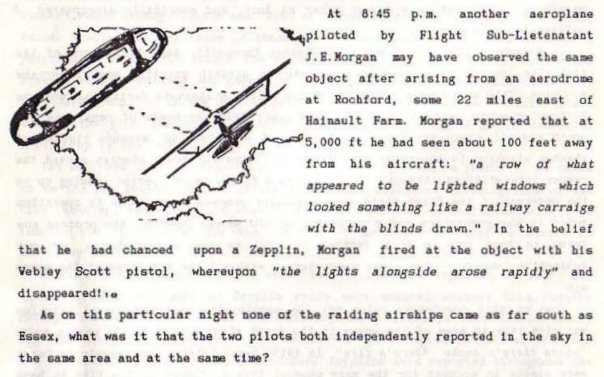
|
At 8.45 pm [on January 31, 1916] another aeroplane, piloted by Flight Sub Lieutenant J.E. Morgan, may have observed the same UFO after arising from an aerodrome at Rochford, some twenty-two miles east of Hainault Farm. Morgan reported that at 5.000 feet he had seen, about a hundred feet away from his aircraft, 'a row of what appeared to be lighted windows which looked something like a railway carriage with the blinds drawn'. In the belief that he had chanced upon a Zeppelin, Morgan fired at the object with his Webley Scott pistol, whereupon 'the lights alongside arose rapidly' and disappeared! As on that particular night none of the raiding airships came as far south as Essex, what was it that these two pilots independently reported in the sky in the same area at the same time?
[Ref. jah1:] JAN ALDRICH:
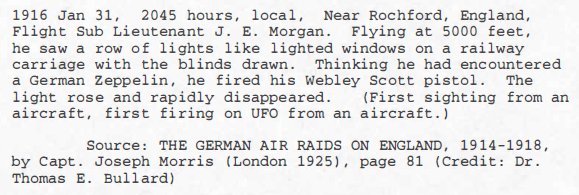
|
1916 Jan 31, 2045 hours, local, Near Rochford, England, Flight Sub Lieutenant J. E. Morgan. Flying at 5000 feet, he saw a row of lights like lighted windows on a railway carriage with the blinds drawn. Thinking he had encountered a German Zeppelin, he fired his Webley Scott pistol. The light rose and rapidly disappeared. (First sighting from an aircraft, first firing on UFO from an aircraft.)
Source: THE GERMAN AIR RAIDS ON ENGLAND, 1914-1918, by Capt. Joseph Morris (London 1925), page 81 (Credit: Dr. Thomas E. Bullard)
[Ref. gvo1:] GODELIEVE VAN OVERMEIRE:
1916, January 31
ENGLAND, near Rochford
Local times: 8:45 p.m., pilot: Sub Lieutenant J. E. Morgan. Flying at 5000 feet he saw a row of lights resembling windows obscured by light shutters, such as those on a railway wagon. Believing he was dealing with a German Zeppelin, he fired his Webley Scott towards the object, which quickly rose and disappeared. (Source: THE GERMAN AIR RAIDS ON ENGLAND, 1914-1918, by Capt. Joseph Morris - London 1925, page 81, cfr Thomas E. Bullard)
[Ref. jck1:] JEROME CLARK:
The case was discussed in US ufologist Jerome Clark's book “Strange Skies” in 2003; it was based on Captain Joseph Morris's book. Clark commented that for weather risks reasons, most Zeppelin attacks took place between March and September, but that this is not proof that what Morgan saw was not a Zeppelin. He notes that what Morgan saw seemed however a little odd, and that the report is brief and somewhat cryptic, and that this may be or may not be the first pilot sighting of an unidentified flying object.
[Ref. prt1:] JAN ALDRICH - "PROJECT 1947":
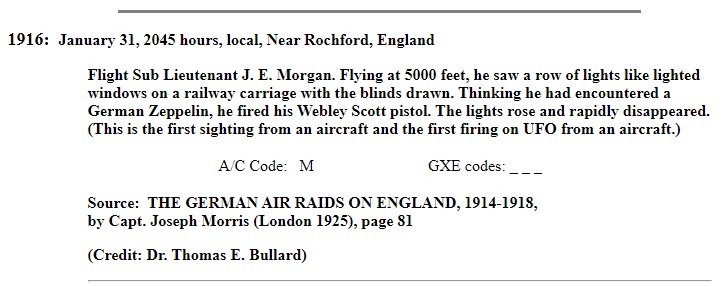
|
1916: January 31, 2045 hours, local, Near Rochford, England
Flight Sub Lieutenant J. E. Morgan. Flying at 5000 feet, he saw a row of lights like lighted windows on a railway carriage with the blinds drawn. Thinking he had encountered a German Zeppelin, he fired his Webley Scott pistol. The lights rose and rapidly disappeared. (This is the first sighting from an aircraft and the first firing on UFO from an aircraft.)
A/C Code: M GXE codes: _ _ _
Source: THE GERMAN AIR RAIDS ON ENGLAND, 1914-1918, by Capt. Joseph Morris (London 1925), page 81
(Credit: Dr. Thomas E. Bullard)
[Ref. dwn1:] DOMINIQUE WEINSTEIN:
French ufologist Dominique Weinstein compiled a catalogue of the cases of UFOs observed from aircraft ([dwn1]). The first case in February 2001 (6th edition) catalogue appears as:

|
| DATE | 16.01.31 |
|---|---|
| TIME | 20:45 LT |
| COUNTRY | UK |
| LOCATION | near Rochford |
| M | |
| TYPE OF PLANE AND WITNESSES | pilot |
| UFO DESCRIPTION | one row of lights like lighted windows on a railway carriage. It rose and disappeared |
| Radar | |
| G | |
| X | |
| E | |
| SOURCES | 03 |
The source “03” is referenced at the end of the catalogue as:
03 Project 1947 Reports, newsclippings and documents (cases from Jan Aldrich and Barry Greenwood)
[Ref. dce2:] DR. DAVID CLARKE:
A 2004 publication where this case appears was by Dr. David Clarke [dce1], on the Web on his website “The Real UFO Project”:
Some 20 miles east of Hainault Farm was another of London's fighter aerodromes at Rochford in Essex. It was from here at 8.45pm that Flight Sub-Lieutenant J.E. Morgan arose for an anti-Zeppelin patrol in his BE2C fighter. Morgan, in an official report to the Admiralty, said that when he reached 5,000 feet he saw a little above his own altitude and slightly ahead to his right, about 100 feet away from his plane, “a row of what appeared to be lighted windows which looked something like a railway carriage with the blinds drawn.”
Believing that he had flown directly into the path of a hostile Zeppelin preparing an attack upon Central London, Morgan drew his Webley Scott service pistol, aimed and fired several times in the direction of the “railway carriage.” Immediately, “the lights alongside rose rapidly” and disappeared into the inky blackness, so rapidly in fact that Morgan believed his own aircraft had gone into a dive. By now Morgan had completely lost his bearings, and after a lengthy battle to bring his aircraft under control he was forced to make a crash landing on the Thameshaven Marshes.
A full account of Morgan's sighting, dubbed “an encounter with a phantom airship” appears in Captain Joseph Morris's official history of the German air raids, The War in the Air, published in 1925. The book was compiled from then classified records, and Morris refers directly to the airman's report filed with the War Office. Extensive searches of the Royal Flying Corps and Royal Naval Air Service records at the Public Record Office have failed to locate Morgan's original report. The station log from Rochford aerodrome does give brief details of Morgan's flight with the addition of the word “Zepp” which shows the pilot and his station commander believed he had had an encounter with something he took to be an enemy airship.
Morgan's report is not included in the official account of the 31 January, 1916 raid published by the War Office which charts the movements of the Zeppelins and the attempts by British fliers to intercept them in great detail. Historians have been left with the impression that the authorities gave no credence to his report. Here we have the first evidence of what has become a long tradition on the part of the War Office, and its successors the Air Ministry and today's Ministry of Defence, of 'down-playing' reports by military pilots of unidentified flying objects.
There was, in fact, additional support for the claim that an airborne object of some kind was present over London during the air raid. A fourth RFC pilot, McClelland, reported seeing what he described as “a Zeppelin” caught briefly in the glare of searchlights above London at 9 pm, 15 minutes after Morgan's encounter.
McClelland's report was in fact the subject of a comment by the Third Sea Lord, Rear-Admiral F.C.T Tudor, who dismissed it in one single paragraph which reads:
“Night flying must be difficult and dangerous, and require considerable nerve and pluck, but this airman seems to have been gifted with a more than usually vivid imagination.”
Historians of the Great War have used the phrase 'phantom airship' to describe inexplicable aerial phenomena. In later years broadly similar sightings were categorised by the largely baffled Air Ministry as 'ghost planes' and 'flying saucers.' Almost a century later we are no closer to explaining what was independently reported by four experienced pilots long before the phrase “UFO” was invented.
References:
[Ref. dce3:] DR. DAVID CLARKE:
David Clarke also reported on this sighting in his 2013 book “The UFO Files: The Inside Story of Real-life Sightings”.
He told that shortly before 8.30 p.m., two Royal Flying Corps pilots flying B.E.2c biplanes reported they were pursuing moving lights at 10,000 feet above Central London. Then they lost their targets in clouds, and, says Clarke, it seems possible they had actually spotted lights on each other's planes, but, he says, another sighting by a Royal Navy pilot is much more difficult to explain:
At 8;45 p.m. Flight Sub-Lieutenant Eric Morgan took off from the Royal Naval Air Service station at Rochford in Essex and began to patrol at 6,400 feet when his engine started misfiring, and this is when he saw, a little above his own altitude, slightly ahead to his right, about 100 feet away from his plane, “a row of what appeared to be lighted windows which looked something like a railway carriage with the blinds drawn”.
He thought he had come face to face with a Zeppelin preparing an attack upon Central London, so he drew his Webley & Scott pistol and fired. Immediately, “the lights alongside rose rapidly” and disappeared into the black sky, so rapidly that Morgan believed his own aircraft had gone into a dive. He struggled to bring his plane back under control and was forced to make an emergency landing on the Thameshaven Marshes.
Clarke says an account of Morgan's sighting, described as “an encounter with a phantom airship”, appears in Captain Joseph Morris's official history “The German Air Raids on Great Britain 1914-18“, published in 1925 and based upon then classified records. Clark notes that Morris referred directly to the airman's report filed with the Admiralty, but this report is not mentioned in the official account of the 31 January 1916 raid published by the War Office which charts the flight paths of the Zeppelins and the attempts by British fighters to intercept them. As a result, says Clark, historians have been left with the impression that the authorities gave no credence to it.
[Ref. bhn1:] BRETT HOLMAN:
Brett Holman - 13 March 2010
On the last night of January 1916, a large force of seven Zeppelins crossed over the Wash into Norfolk, heading for the industrial cities of the Midlands. Unsure of their location, most of them instead dropped their bombs on relatively unimportant targets. But at least they got home okay. The defending aircraft of the RFC and RNAS had an awful night: 22 sorties resulted in six aircraft being written off, two squadron commanders killed and no contacts with the enemy.
Or at least ... no confirmed contacts with the enemy. Four pilots did report seeing something, but they were well to the south of the probable Zeppelin flightpaths, over London and Essex, and so their reports were dismissed by those higher-up as mistaken identities, phantom airships. At 7.40pm, Lieutenant R. S. Maxwell saw 'an artificial light' north of his B.E.2c while 10000 feet above London, and gave chase before losing it in clouds. 2nd Lieutenant C. A. Ridley, another B.E.2c pilot, also saw a 'moving light' over London at about the same time, and so they may have actually seen each other. Later in the night, at around 9pm, Flight Sub-Lieutenant H. McClelland (also flying a B.E.2c) also thought he saw 'a Zeppelin' by searchlight over London.
Strangest of all was the report of Flight Sub-Lieutenant J. E. Morgan, an RNAS pilot who sortied in his B.E.2c from Rochford in Essex at about a quarter to nine. At 5000 feet, slightly above and to starboard, he spotted
a row of what appeared to be lighted windows which looked something like a railway carriage with the blinds drawn.
(This is apparently a quote from Morgan's after-action report.) Thinking that this was a Zeppelin only a hundred feet away -- and presumably having no time to maneuver for a better shot -- he fired his Webley at it! It then seemed that 'the lights alongside rose rapidly' and disappeared. Morgan then started looking for somewhere to land: he saw some lights below which he thought was Southend Pier but turned out to be a Dutch steamer off Thameshaven. He managed to put down safely and flew back to Rochford the following day.
This episode has been assimilated into UFO lore as an early military encounter, a precursor of the foo fighters of the Second World War. There are a few scanty accounts on the net, but easily the best -- here and here -- is by David Clarke, who lectures in journalism at Sheffield Hallam University. He has worked closely with the National Archives in recent years with regards to their release of official documents relating to UFO sightings.
Clarke looked for Morgan's original report, but has not been able to find it. (He did find other documents, such as the Rochford aerodrome log which notes 'Zeppelin' next to Morgan's flight.) So he drew on the (very short) quotes from it given in Joseph Morris's The German Air Raids on Britain, 1914-1918 (Dallington: Naval & Military Press, 1993 [1925]), 81-2, which perhaps could be considered a semi-official history: it was certainly written with privileged access to official records of the services and ministries involved. Morris doesn't venture an explanation for what Morgan saw, other than that it was a 'phantom airship', and if this is all we have to go on it does sound mysterious.
But, looking at Christopher Cole and E. F. Cheesman, The Air Defence of Britain 1914-1918 (London: Putnam, 1984), 83-9 (which Clarke also cites), they provide details which aren't in Morris. For example, they say that when the row of lights 'rose rapidly', Morgan at first thought his B.E.2c was diving, but an instrument check showed that it wasn't. So either Morgan's report was still extant in the early 1980s when Cole and Cheesman wrote their book, or they had another source (or else just made stuff up, which doesn't seem their style). Morgan himself was killed in 1917, so it probably wasn't him. I'd guess they did see the original report, or perhaps a different precis of it, as they give a quote which is similar to that in Morris, but not identical:
a row of lighted windows ... something like a railway carriage with the blinds down.
Maybe this source is still out there somewhere? If so, it might shed some light on what it was that Morgan actually saw. Cole and Cheesman suggest that it might have been the Zeppelin L16 (which theory ufologists don't seem to mention). An airship gondola could well look 'something like a railway carriage with the blinds drawn': it wouldn't be well-lit, but I think there would be some light coming from inside. As noted above, L16 was supposed to have been much further north, but tracing the actual routes taken by airship raiders can be quite hard. The airship captains usually didn't know where they were, the pilots who flew against them often didn't know where they were, and the defenders on the ground often didn't see anything at all. The most reliable indicator of a Zeppelin's position is usually the bombs it dropped, but L16 turned back early due to engine trouble. So perhaps this explains Morgan's sighting. On the other hand, would a Zeppelin captain respond to being shot at by a pistol by climbing rapidly? Unlikely: he wouldn't even have noticed it. He might have seen the B.E. and dropped ballast to outclimb it, though, maybe into a layer of cloud which would explain why it disappeared.
But otherwise, if it wasn't an airship, what might Morgan have seen?
[Ref. vie1:] "VIRMUZE" WEBSITE:
Though firsthand reported sightings before 1939 were sparse, Haines' compilation of UFO sightings starts in World War I. One of the earliest recorded instances of a UFO sighting may have been in 1916 when Flight Sub-Lieutenant J.E. Morgan reported having seen “a row of what appeared to be lighted windows which looked something like a railway carriage with the blinds drawn” while flying above Rochford, England. Morgan fired at the aircraft which appeared to only be about a hundred feet away, but “the lights alongside rose rapidly” and vanished. According to another UFO incident compiler, “This is the first sighting from an aircraft and the first firing on [a] UFO from an aircraft.”
[Ref. wag1:] "THE WANDERLING":
According to ZEPPELINS: High Altitude Warships, on the night of January 19, 1915 two German navy Zeppelins carried out the first successful bombing run against British soil. One year later, although not exactly a Foo Fighter in the World War II classical sense, the FIRST sighting of a UFO from a powered aircraft EVER as well as the first firing on a UFO from the air occurred over England.
David Clarke and Andy Roberts write in their book OUT OF THE SHADOWS: UFOs, the Establishment and the Official Cover-up (London: Piatkus, 2002) that early in January 1916 at the fighter aerodrome at Rochford in Essex outside London around 8:45 PM Flight Sub-Lieutenant J.E. Morgan arose for an anti-Zeppelin patrol in his BE2c fighter. When Morgan reached 5,000 feet he saw a little above and slightly ahead to the right about 100 feet away what he described as “a row of what appeared to be lighted windows which looked something like a railway carriage with the blinds drawn.”
Believing that he had flown directly into the path of an oncoming Zeppelin in the act of preparing to attack London, Morgan drew his service pistol and fired several times in the direction of the “railway carriage.” Immediately, “the lights alongside rose rapidly” and disappeared into the night sky, so rapidly in fact that Morgan believed his own aircraft had gone into a dive. Overcorrecting his actually not out of control aircraft he crashed into Thameshaven Marshes.
A full account of Morgan's sighting, dubbed “an encounter with a phantom airship” appears in German Air Raids on Great Britain 1914-1918 by Captain Joseph Morris published in 1925. The book was compiled from then classified Air Ministry records, and Morris refers directly to the airman's report filed with the War Office. Extensive searches of the Royal Flying Corps records at the Public Record Office have failed to locate Morgan's original report. The station log from Rochford aerodrome does give brief details of Morgan's flight with the addition of the word “Zepp” which shows he did have an encounter with something he took to be an enemy airship.
Morgan's report is NOT included in the official account of the January 31, 1916 raid published by the War Office at the end of the conflict, which charts the movements of the Zeppelin raiders and the attempts by British fliers to intercept them in great detail. There is, however, additional support for the claim that an airborne object of some kind was present over southeastern England during the air raid. Another RFC pilot by the name of McClelland, reported seeing what he described as “a Zeppelin” caught briefly in the glare of searchlights above London at 9 pm, 15 minutes after Morgan's encounter.
The Royal Aircraft Factory B.E.2 (B.E. meaning “Blériot Experimental”) was the first U-K. military plane, designed to be a stable reconnaissance platform, in 1912, before WWI, a time when the idea of fighter planes did not exist yet. The B.E.2c was ordered into production to replace the older B.E.2a and B.E.2b. The first production aircraft, built by Vickers, was delivered on December 19, 1914. The B.E.2c was used most effectively as a Home Defence aircraft; its stability became an asset, especially in night operations. Its slow rate of climb was still a problem, but no more than for any other aircraft used against the Zeppelins, which could gain height much quicker than any contemporary aircraft. Twelve squadrons would operate the B.E.2 on home defense duties, more than half of them from early in 1916. It had destroyed several Zeppelins by the end of 1916, forcing the Germans to abandon Zeppelin raids.
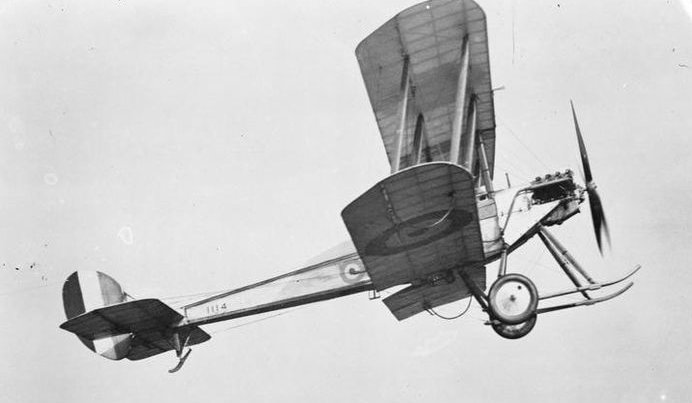
|
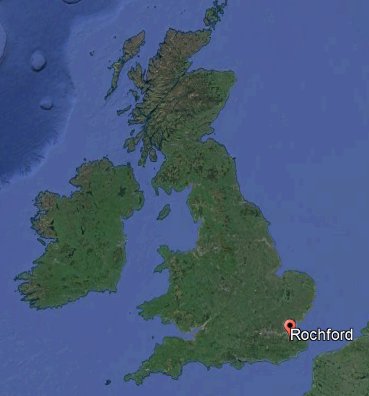
|
Apparently, from various military historical sources, the Rochford airfield, also known as “Hot Farm” apparently, was a Depot Squadron initially, becoming a Night Training Squadron with B.E.2c, B.E.2e & Airco DH.6s aircraft on September 15, 1916. Other sources say it was a Home Defence Station from 1915 to 1918, used by the Royal Naval Air Service, and the Royal Flying Corps.
As can be seen from the primary source [jms1], it appears difficult, at least to me, to exclude that J.E. Morgan was not the victim of some misinterpretation. It appears that he was quite “lost” in the dark night.
The notion that he was “lost” appears when what he thought to be the Southend pier, he realized on coming down, “were the lights of a large Dutch steamer off Thames Haven”.
Obviously, David Clarke located the “PRO Air 1/438 15/300/1. Rochford Station (Naval): report on night landing ground, 1916” report (date February 2, 1916?); from which he apparently got more details than from the book by Captain Joseph Morris. For example when the “UFO” went up, it was done “so rapidly in fact that Morgan believed his own aircraft had gone into a dive”.
It is not certain that it was a misinterpretation of ground lights or ship lights. What seems to go against it is that the “UFO” was “a little above his own level”, and that after he fired at it, “the lights alongside rose rapidly“, suggesting it was not something at ground-level. Also, he thought the “hostile airship” was only some 100 feet away, that is, very, very close.
It is mildly possible that it was what Morgan first thought, a Zeppelin, able to climb quite rapidly; however, the “row of lights” does not make a good case for this.
So, I feel unable to decide what J. E. Morgan saw.
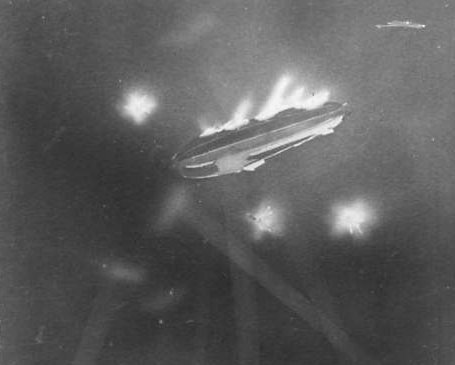
|
Above: Zeppelin caught in searchlights over Scotland, 1916.
The Zeppelin LZ16 is mentioned as the possible explanation. What puzzles me is that the Wikipedia page, and others (http://www.aircraftinvestigation.info/airplanes/Zeppelin_LZ16_ZIV.html), on the LZ16 indicate that the LZ 16 was on the Eastern front, until 24 February 1915, after which it was used only as a training ship. LZ16 was its English designation, the Germans registered it Z IV.
I was able to find a photo of its gondola, taken before the war when this Zeppelin had gotten lost and had to land in Lunéville in France. Below is an excerpt from the photo, showing that this airship had four “windows”:
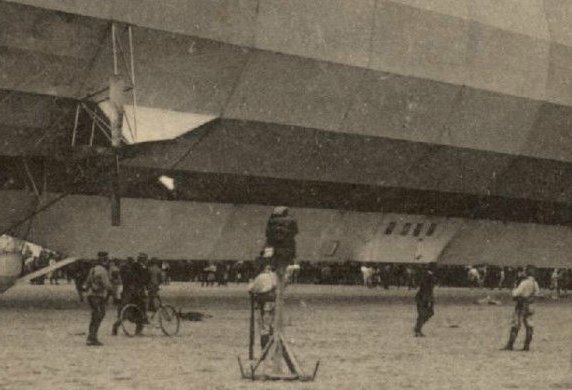
|
It seems unlikely to me - but not impossible of course - that Morgan compared this to railroad wagon windows instead of stating the number of windows as four. The idea of a train wagon brings to mind more than just four windows.
It should also be noted that the previous pilot sighting took place near Romford the same night at about the same time, and the location of this next sighting may be quite the same, as Romford and Rochford are only 36 km away:
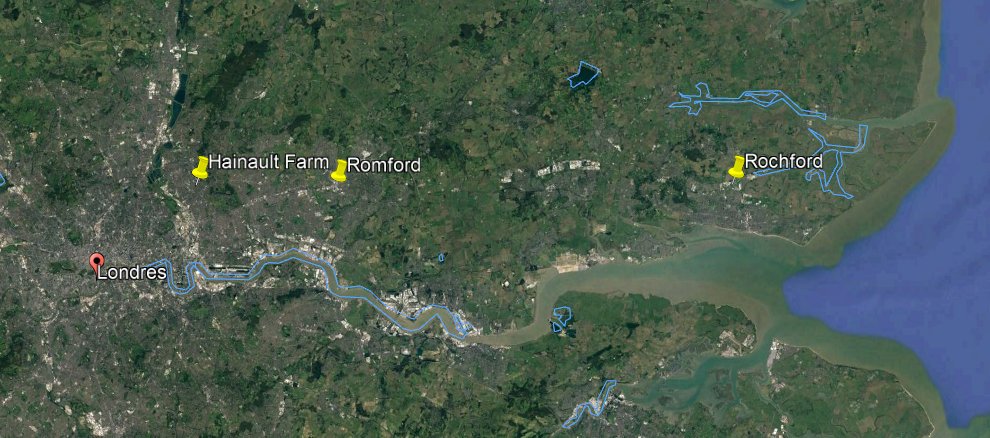
|
Using personal databases of the British pilots of the time, I was able to determine that the witness was John Emil Morgan, born in Finsbury Park, who attended the Central Flying School in 1915, certified there as pilot on Farman Biplane, confirmed Flight Sub-Lieutenant in the Royal Naval Air Service on May 31, 1915 (The London Gazette, October 26, 1915). He died March 30, 1917, at the age of 26, when his Nieuport 12 plane was shot down by German ace Hauptmann Hans-Joachim Buddecke from FAb5 near Smyrna.
Unidentified, possible misinterpretation, insufficient information.
* = Source is available to me.
? = Source I am told about but could not get so far. Help needed.
| Main author: | Patrick Gross |
|---|---|
| Contributors: | None |
| Reviewers: | None |
| Editor: | Patrick Gross |
| Version: | Create/changed by: | Date: | Description: |
|---|---|---|---|
| 0.1 | Patrick Gross | September 23, 2023 | Creation, [jms1], [jck1], [dce1], [dce2], [prt1], [dwn1], [bhn1]. |
| 1.0 | Patrick Gross | September 23, 2023 | First published. |
| 1.1 | Patrick Gross | November 8, 2023 | Additions [dce3], [jah1]. |
| 1.2 | Patrick Gross | June 10, 2024 | Addition [vie1]. |
| 1.3 | Patrick Gross | June 17, 2024 | Addition [wag1]. |
| 1.4 | Patrick Gross | June 26, 2024 | Addition [gvo1]. |
| 1.5 | Patrick Gross | July 19, 2024 | In the Discussion, addition of the "J.E. Morgan" part. |